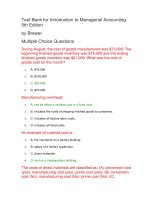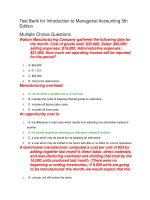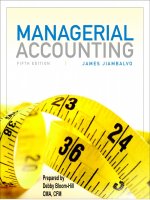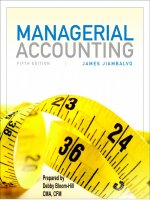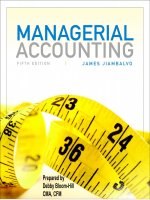Managerial accounting 5th jiambalvo ch01
Bạn đang xem bản rút gọn của tài liệu. Xem và tải ngay bản đầy đủ của tài liệu tại đây (1.78 MB, 39 trang )
Prepared by
Debby Bloom-Hill
CMA, CFM
CHAPTER 1
Managerial Accounting
In the
Information Age
Slide 1-2
Managerial Accounting
Managerial accounting is designed for
internal users
The goal of Managerial Accounting is
to provide the information managers
need for
Planning
Control
Decision making
Slide 1-3
Learning objective 1: State the primary goal of
managerial accounting
Planning
Planning is a key activity for all
companies
Communicates a company’s goals to
employees
Aids coordination of various functions
such as sales and production
Specifies the resources needed to
achieve company goals
Slide 1-4
Planning
Budgets for planning
Profit budget
Indicates planned income
Cash flow budget
Indicates planned cash inflows and
outflows
Production budget
Indicates the planned quantity of
production and expected costs
Slide 1-5
Learning objective 2: Describe how budgets
are used in planning
Planning
Slide 1-6
Learning objective 2: Describe how budgets
are used in planning
Control
Organizations achieve control by:
Evaluating managers to determine how
their performance should be rewarded
or punished
Evaluating operations to provide
information as to whether they should
be changed or not
Slide 1-7
Learning objective 3: Describe how performance reports are
used in the control process
Planning and Control Process
Slide 1-8
Learning objective 3: Describe how performance reports are
used in the control process
Sample Performance Report
Slide 1-9
Learning objective 3: Describe how performance reports are
used in the control process
Managerial vs Financial
Accounting
Unlike Financial Accounting,
Managerial Accounting:
Is directed at internal users
May deviate from GAAP
Presents more detailed information
May present more nonmonetary
information
Places more emphasis on the future
Slide 1-10
Learning objective 4: Distinguish between financial
and managerial accounting
Variable Costs
Change in proportion to changes in volume
or activity
Slide 1-11
Learning objective 5: Define cost terms used in
planning, control, and decision making
Fixed Costs
Do not change in response to changes in
volume or activity
Slide 1-12
Learning objective 5: Define cost terms used in
planning, control, and decision making
Test Your Knowledge 1
Which of the following is most likely to be a
variable cost?
a. Depreciation
b. Cost of materials
c. Rent
d. Advertising
Answer:
b. Cost of materials
Slide 1-13
Learning objective 5: Define cost terms used in
planning, control, and decision
Test Your Knowledge 2
Which of the following is most likely to be a
fixed cost?
a. Cost of materials
b. Rent
c. Assembly labor cost
d. Commissions
Answer:
b. Rent
Slide 1-14
Learning objective 5: Define cost terms used in planning,
control, and decision making
Cost Terminology
Sunk Costs
Costs incurred in the past
Not relevant to present decisions
Opportunity Costs
Values of benefits foregone when
selecting one alternative over another
Slide 1-15
Learning objective 5: Define cost terms used in planning,
control, and decision making
Test Your Knowledge 3
Costs incurred in the past are:
a. Opportunity costs
b. Direct costs
c. Sunk costs
d. Variable costs
Answer:
c. Sunk costs
Slide 1-16
Learning objective 5: Define cost terms used in
planning, control, and decision making
Cost Terminology
Direct and indirect costs
Direct costs are directly traceable to a
product, activity, or department,
indirect costs are not traceable
Controllable and non-controllable
costs
A manager can influence controllable
costs but cannot influence noncontrollable costs
Slide 1-17
Learning objective 5: Define cost terms used in
planning, control, and decision making
Direct and Indirect Cost
Slide 1-18
Learning objective 5: Define cost terms used in
planning, control, and decision making
Test Your Knowledge 4
In the past year, Williams Mold & Machine had
sales of $8,000,000 and total production costs
of $6,000,000. In the coming year, the company
believes that production can be increased by
30%, but this will require adding a second shift
to work from 4:00 pm to 1:00 am.
1.
Indicate three production costs that
are likely to increase because of adding a
second production shift.
Material costs, workers’ salaries,
and benefits are all likely to increase
Slide 1-19
Learning objective 5: Define cost terms used in
planning, control, and decision making
Test Your Knowledge 5
In the past year, Williams Mold & Machine had sales of
$8,000,000 and total production costs of $6,000,000. In
the coming year, the company believes that production
can be increased by 30%, but this will require adding a
second shift to work from 4:00 pm to 1:00 am.
2. What production cost most likely will not
increase when the second shift is added?
Depreciation of the building will not
increase
Slide 1-20
Learning objective 5: Define cost terms used in
planning, control, and decision making
Two Key Ideas in Managerial
Accounting
Slide 1-21
Learning objective 6: Explain the two key
ideas in managerial accounting
Incremental Analysis
• Incremental analysis:
Differences in revenues and costs
between alternatives are incremental
Incremental revenue minus incremental
cost equals incremental profit
Slide 1-22
Learning objective 6: Explain the two key
ideas in managerial accounting
You Get What you Measure
Performance measures greatly influence
the behavior of managers
Slide 1-23
Learning objective 6: Explain the two key
ideas in managerial accounting
You Get What you Measure
Slide 1-24
Learning objective 6: Explain the two key
ideas in managerial accounting
Information Age and Managerial
Accounting
Advances in information technology
have:
Increased competition and also created
opportunities and cost savings for firms
that use information for strategic
advantage
Impacted information flows up and
down the value chain (i.e. fundamental
activities that a firm engages in to
create value)
Slide 1-25
Learning objective 7: Discuss the impact of information technology on competition, business processes and
the interactions companies have with suppliers and customers
